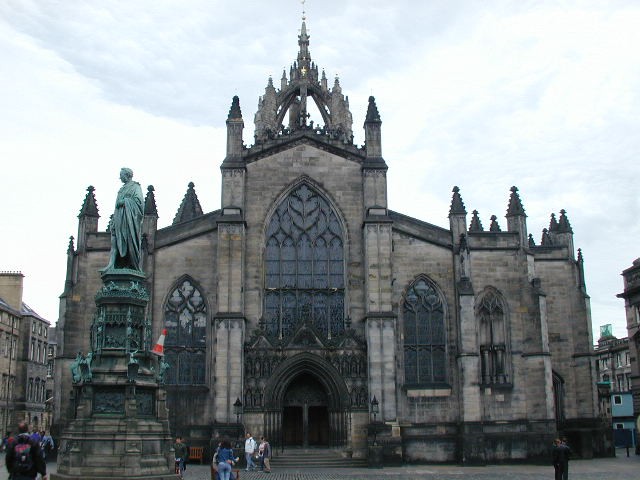

We spent all of today in Edinburgh, which I found I had been saying incorrectly; it's pronounced as if it were spelled "Edinborough." Go figure. Anyway, we started in St. Giles cathedral, where we presented an informal concert after a brief noontime service of scripture reading and prayer. St. Giles was only officially a cathedral, that is, the seat of a bishop, for a brief time several hundred years ago; for the last few centuries it has been the national kirk (church) of Scotland, and the mother church of Presbyterianism. The statue in the foreground is of Sir Walter Scott.
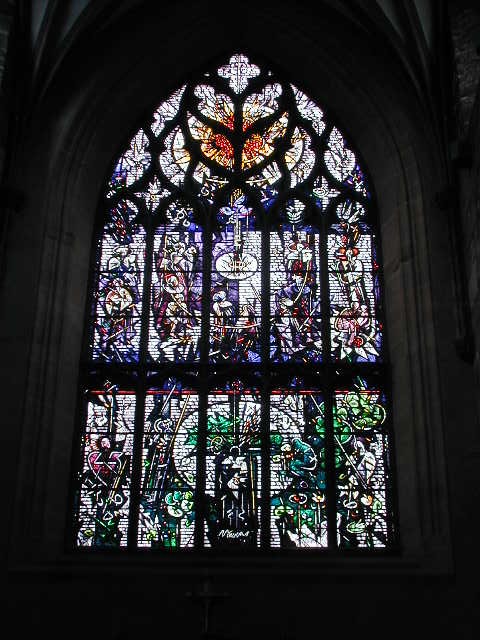
Most of the windows inside, and much of the structure, dates only to the 19th or even the 20th centuries. This is because during the Reformation of the late 16th century, the reformers replaced interior furnishings, decorations, and glass with much simpler ones as a reaction against the perceived excessive luxury of the Roman Catholic church, and only in the last couple of centuries has restoration work been undertaken. This window has a metal plaque set in the floor in front of it, which says "This window celebrates ROBERT BURNS, poet of humanity, 1985," so it's quite recent.
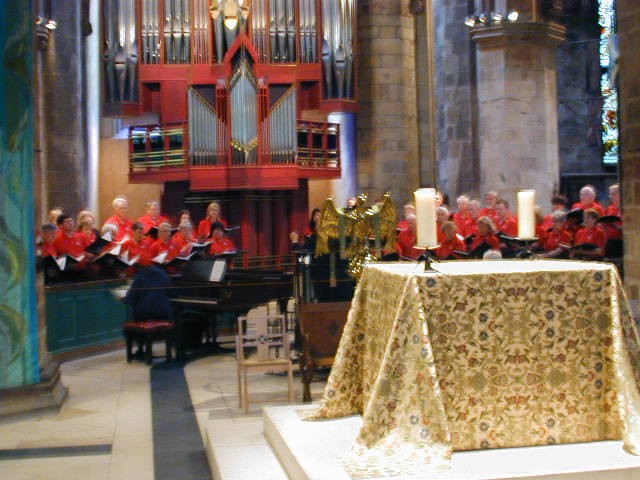
Here we are singing near the oldest surviving part of the church, the four great central pillars that date to 1124. We didn't use the organ, but it sure made an impressive backdrop... It was especially appropriate given the window in the picture above, we thought, to sing two of our songs that are musical settings of Burns' poems. The photo was taken by Steve Campbell, not my wife Cheryl as before, since she felt that her voice was ready to sing again after her cold and thus joined the concert!
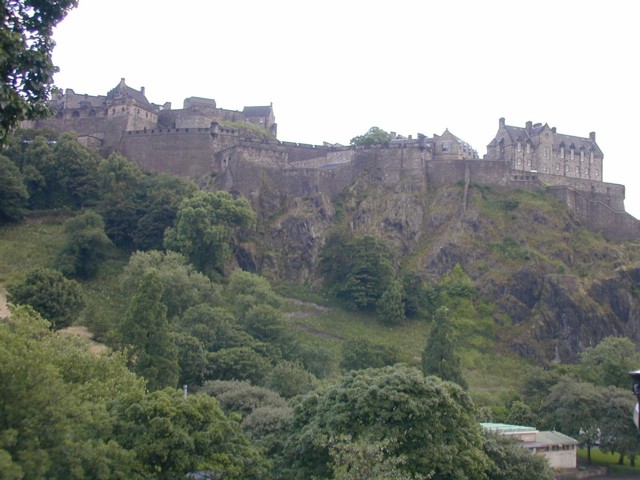
After the concert we were free to spend the rest of the day sightseeing, shopping, and getting lunch and dinner on our own. Cheryl and I first went to Edinburgh Castle, up on the old volcanic mountain above the city. Evidence of settlement on this obviously defensible point goes back 3000 years or so; the castle was begun in the late 11th century. Two centuries later it was taken by the English King Edward I, the same king who built Conwy Castle, which we saw in Wales on Wednesday. When retaken after his death by the forces of the Scottish king Robert the Bruce the castle was razed (except for one small chapel, which still stands today) to prevent the English from reoccupying it. The mountain changed hands again a couple of times and in the mid-14th century David II, son of Robert the Bruce, began to rebuild it, resulting in much of the structure we see today. More wars (through as late as 1745!) resulted in bombardments, demolitions, and rebuildings, so that the current structure is a mix of 11th- through 19th-century architecture.
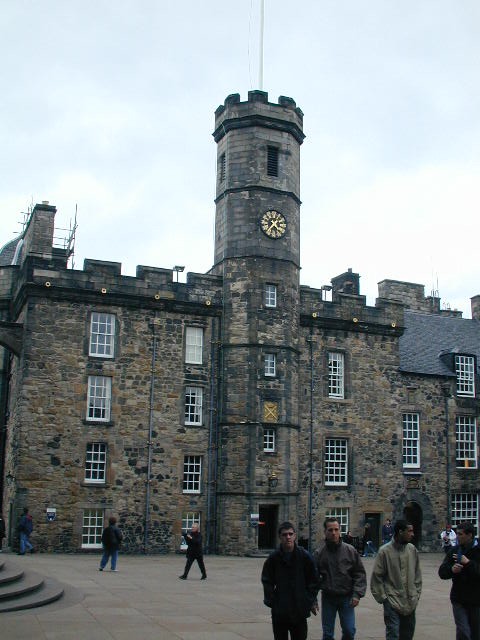
Here is the Royal Palace, in the Upper Ward of the castle next to a former barracks that was remade into the Scottish National War Memorial after the First World War. (A casket containing a list of names of the fallen rests inside on an outcrop of volcanic stone, the highest point of the mountain.) In the Royal Palace, Mary Queen of Scots gave birth in 1566 to the future King James VI, who would unite the English and Scottish crowns as King James I of England upon the death of Queen Elizabeth I. Also in the Palace is the Crown Room, which was built in 1615-1617 to house the "Honours of Scotland": the Crown, Sword, and Sceptre of Scottish royalty.
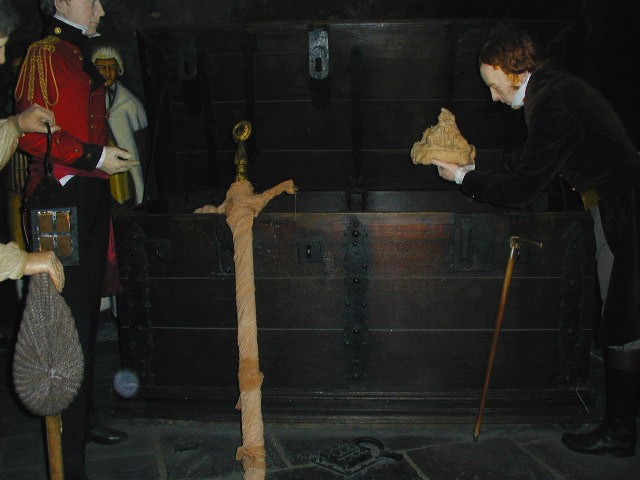
There is an exhibition, opened by the current Queen Elizabeth II in 1993, that depicts scenes in the long and eventful history of the Honours of Scotland. The Crown is the oldest in Britain (since Cromwell destroyed the then English crown in the mid-17th century, but the Scottish Honours were kept hidden from his forces) and the second oldest in Europe, and the Sword and Sceptre were gifts from the then Popes to King James IV in the late 15th and early 16th century. After the Treaty of Union between England and Scotland in 1707, the royal functions of the Honours of Scotland were ended, and they were sealed in an oaken chest and put away for 111 years. The scene pictured above shows the opening of the chest and recovery of the Honours after its resting place had been ferreted out by Sir Walter Scott; the chest in the scene is the actual chest where they were hidden.
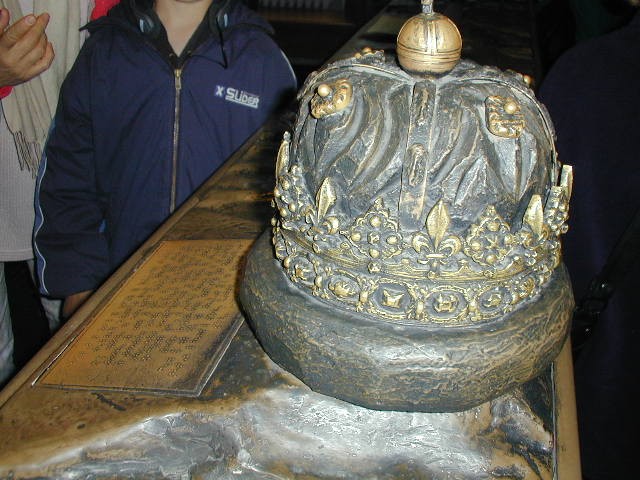
For security reasons, photography is not allowed in the Crown Room, but here's a shot of something that we thought was really a great idea. Just before you enter the Crown Room, there is a room with close-up photos and descriptions of the construction and features of the Crown, Sword, and Sceptre. As pictured here, there is also a sculpted model of each along with a Braille description, so blind visitors can examine the details too! Does that show some thoughtfulness, or what? Also in the Crown Room is the Stone of Destiny, or Stone of Scone, on which Scottish kings (and prior tribal kings) had sat when they were crowned for hundreds of years until it was taken from Scone Abbey in 1296 by Edward I (again!). It was built into the Coronation Chair in Westminster Abbey in London, and all subsequent English monarchs, and then monarchs of the United Kingdom, were crowned while seated on it. In 1996, however, it was moved back to Scotland to rest beside the Honours until needed for the next coronation; at that time it will be transported from Edinburgh to London and then back.
Cheryl and I have found that open-top bus tours are a good addition to a visit to a city; you can get some good photos (like the one of the castle above) and you learn a lot of bits of local lore. For example, there's the story of Greyfriars Bobby, a Skye Terrier who stood guard at his master's grave for 14 years and who is memorialized by a statue and the name of a local pub near the graveyard. Or there's the strange case of Deacon Brodie, a respected churchman by day and a robber by night, who inspired the story of Dr. Jekyll and Mr. Hyde. We'll keep looking for such tours on other cities we visit, and we recommend them to other travelers!
 To
Sunday, 7 July 2002
To
Sunday, 7 July 2002 Back
to choir tour itinerary
Back
to choir tour itinerarynew 6 July 2002, revised 21 July 2002